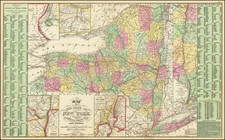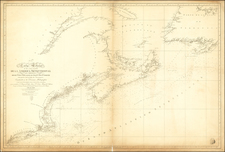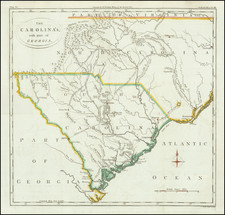Second State of Faden's Plan of the Battle of Valcour Island -- Captain Thomas Pringle Named As the Commanding Officer of the British Forces
Nice example of Faden's battle plan of the Battle of Valcour Island, one of the rarest of all printed battle plans for the American Revolution.
Faden's plan is the definitive record for Benedict Arnold's engagement with the British fleet at Valcour Island, on Lake Champlain. The engagement was the high point in Benedict Arnold's military career, although he would later become the most famous traitor of the Revolution. Faden's plan, which was reportedly derived from, "a sketch taken by an Officer on the Spot," accurately depicts the movements of the two naval squadrons, as well as the tracks of the retreat of the American survivors back to Fort Ticonderoga on the evening following the initial action.
While the British had technically defeated the Americans at Valcour Island, Arnold's delaying tactics forced the British to return to Canada for the winter, thereby delaying the British plan to march these forces south to join General Howe on the Hudson River.
The map originally bore the name of Sir Guy Carleton, the commander of the British Forces at Valcour Island. However, once it became clear that the battle had been a failure for the British, Faden was ordered to remove Carleton's name most likely because the British viewed Valcour Island as a significant military failure, leading Carleton or his supporters to ask that Faden remove all evidence of Carleton's command. Nebenzahl notes that, "It is generally conceded that if the British had reached Albany that winter the American Revolution could have collapsed altogether."
Faden published a series of famous battle plans for the Revolution, of which this example is the rarest and is especially desirable with the additional text panels below the plan.
The second edition replaces Guy Carleton's name with Pringle's name in the title. This edition is known in 2 states, one with text, one without.
William Faden (1749-1836) was the most prominent London mapmaker and publisher of the late-eighteenth and early-nineteenth centuries. His father, William Mackfaden, was a printer who dropped the first part of his last name due to the Jacobite rising of 1745.
Apprenticed to an engraver in the Clothworkers' Company, he was made free of the Company in August of 1771. He entered into a partnership with the family of Thomas Jeffreys, a prolific and well-respected mapmaker who had recently died in 1771. This partnership lasted until 1776.
Also in 1776, Faden joined the Society of Civil Engineers, which later changed its name to the Smeatonian Society of Civil Engineers. The Smeatonians operated as an elite, yet practical, dining club and his membership led Faden to several engineering publications, including canal plans and plans of other new engineering projects.
Faden's star rose during the American Revolution, when he produced popular maps and atlases focused on the American colonies and the battles that raged within them. In 1783, just as the war ended, Faden inherited his father's estate, allowing him to fully control his business and expand it; in the same year he gained the title "Geographer in Ordinary to his Majesty."
Faden also commanded a large stock of British county maps, which made him attractive as a partner to the Ordnance Survey; he published the first Ordnance map in 1801, a map of Kent. The Admiralty also admired his work and acquired some of his plates which were re-issued as official naval charts.
Faden was renowned for his ingenuity as well as his business acumen. In 1796 he was awarded a gold medal by the Society of Arts. With his brother-in-law, the astronomer and painter John Russell, he created the first extant lunar globe.
After retiring in 1823 the lucrative business passed to James Wyld, a former apprentice. He died in Shepperton in 1826, leaving a large estate.









![[Niagara Falls] Cataracte de Niagara](https://storage.googleapis.com/raremaps/img/small/96890.jpg)

![[Flint River Falls / Finger Lakes] Chute de la riviere des pierres a chaux | Falls on the Flint River](https://storage.googleapis.com/raremaps/img/small/91335.jpg)
![Carte Du Canada ou de la Nouvelle France et des Decouvertes qui y ont ete faites . . . [Map of Canada or New France and the Discoveries Made Therein . . .]](https://storage.googleapis.com/raremaps/img/small/94450.jpg)

